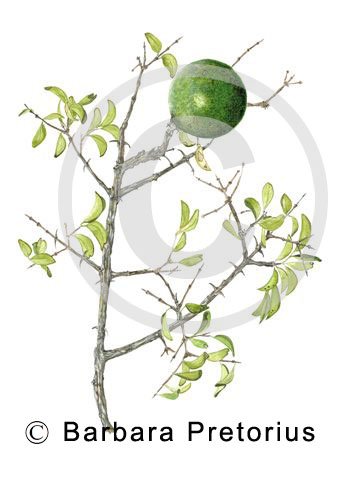Strychnos cocculoides

Author: Ivan Lätti
Photographer: Botanical art by Barbara Pretorius
The edible fruit of Strychnos cocculoides makes this a favourite, especially with children. The corky monkey-orange or in Afrikaans the kurkbasklapper (cork bark cracker), is a small tree reaching heights from 2 m to 8 m (SA Tree List No. 623).
The bark on the straight, upright stem is corky, creamy brown and longitudinally ridged. Young branches are thick, purplish, long-haired and armed with curved spines. Branchlets often end in spines.
The opposite, stalked leaves have small, ridged stipules. The leaf-shape is broadly ovate, oblong or nearly circular, tapering or rounded at both ends. The dark green, glossy blades are sometimes hairy. Three to seven veins spread from or near the base and converge at the leaf-tip. Leaf margins are entire. Leaf dimensions are from 2,5 cm to 5 cm long and 1,5 cm to 4 cm wide.
The bisexual flowers are small, greenish white, growing in compact heads at stem-tips. The calyx lobes are almost as long as the petals.
The woody-shelled, spherical fruit, green with white speckles, turns yellow to orange when it ripens in autumn; about 7 cm in diameter. Many seeds are embedded in an edible pulp.
The species distribution is in Mpumalanga and Limpopo, as well as in tropical Africa. The habitat is woodland and bushveld, the trees growing in sandy soil, often on rocky slopes. The species is not considered to be threatened in its habitat early in the twenty first century.
The tree is commonly planted in Tanzania and has been earmarked for domestication in fruit production, but not seen in South African gardens often enough (Coates Palgrave, 2002; Schmidt, et al, 2002; www.plantzafrica.com; http://redlist.sanbi.org).

